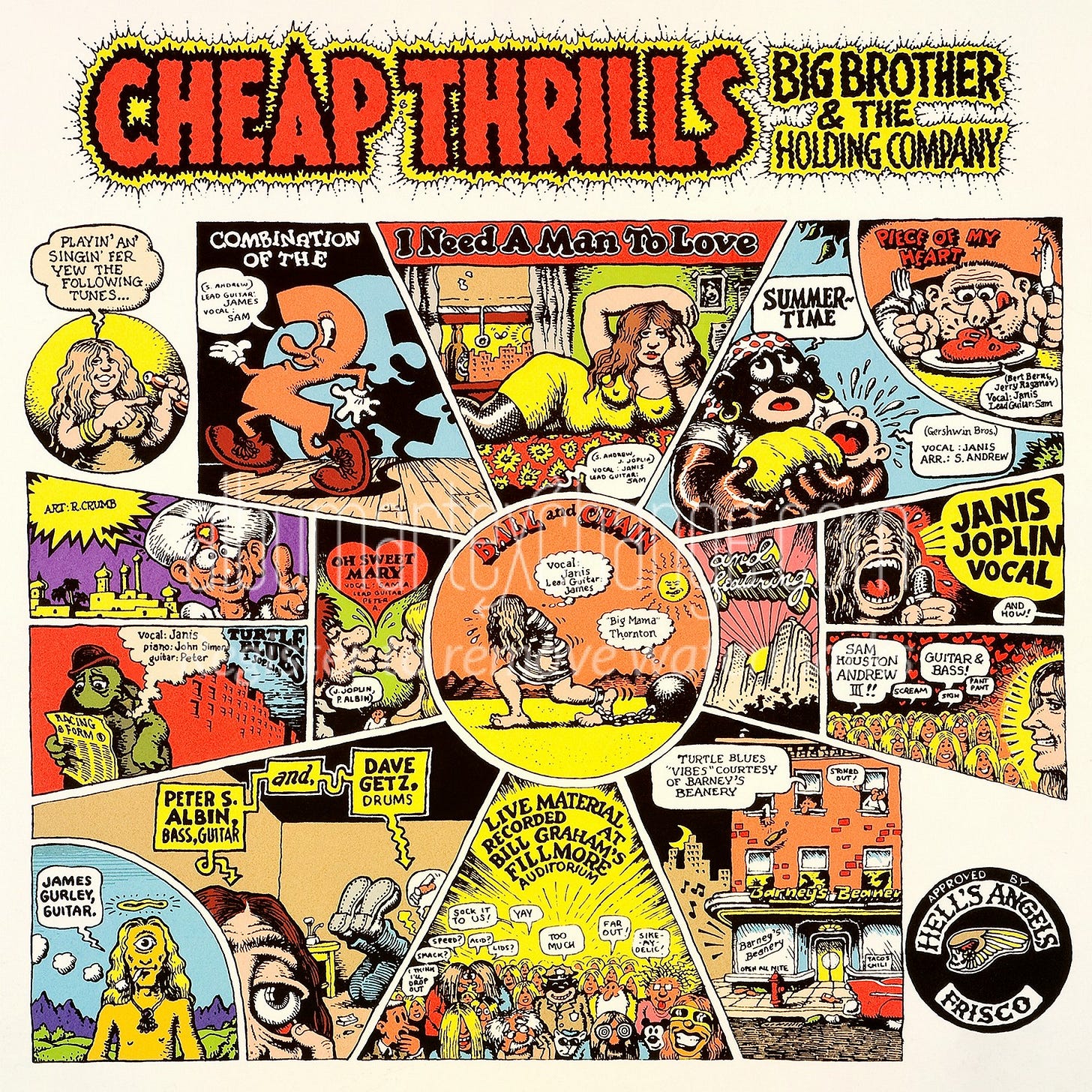Big Brother & The Holding Company: The 1978 Sam Andrew and James Gurley Interview, Part 1
On Janis Joplin, Jimi Hendrix, San Francisco, and the Psychedelic 1960s
Note to readers: This is the second part of a three-part series.
The following two-hour interview with Sam Andrew and James Gurley took place on September 30, 1978, in San Rafael, California. Both guitarists had come to town to participate in Big Brother & The Holding Company’s first reunion since disbanding five years earlier. Kathi McDonald, who’d auditioned for Big Brother before Janis Joplin got the gig, was brought in to sing lead vocals. (A solo artist in her own right, Kathi had worked as an in-demand backup singer, appearing on Leon Russell and the Shelter People, the Rolling Stones’ Exile on Main Street, and other high-profile recordings.)
Family Dog founder and concert promoter Chet Helms had invited photographer Jon Sievert and me to attend Big Brother’s day-long rehearsal. Having been a fan of Big Brother’s groundbreaking Cheap Thrills, one of the defining psychedelic releases of 1960s, I brought along my tape recorder and a list of questions. James and Sam, it turned out, were both readers of Guitar Player magazine and were happy to do interviews. I began with a solo interview with James (posted here: Big Brother & The Holding Company: The 1978 James Gurley Interview). At the tail end of that one, Sam joined us. The interview below takes up where that one left off. Friendly and open, James and Sam instantly made me feel at home.
The day after our interviews, Big Brother & The Holding Company performed at the Tribal Stomp concert at the Greek Theater in Berkeley, California. It would be another nine years before they’d perform together again.
***
When you started playing together, how did you work out parts?
Sam Andrew: Spontaneously.
James Gurley: Yeah. Our first method would be to just play the thing any way we could. We’d have a general idea of what we wanted to do, and we’d try it each man for himself. Just figure out what you want to do and jam it all together. We’d see what we had, and then we’d sort of take it apart and see what didn’t fit. Throw that out. Isn’t that the way it worked, Sam, or am I making this up?
Sam: [Laughs.] No. We played just like we’re doing now – through the changes.
James: The main thing was to approach it from a feeling standpoint, an emotional standpoint of what we were trying to do, and not get too involved with the nuts and bolts right at first. Get sort of an idea of what is there, and then you can shape it. Clean it up after you get a general mold of what’s there. Bring it into focus by leaving one chord out or putting another chord in, or whatever it was that was needed to make the song flow along.
What was the difference when Janis came into the band? How did it change the inner-workings?
Sam: Naturally it became more organized around vocals, whereas before we were really trying to do more instrumentals.
James: We did a mostly instrumental thing. And we started doing more organized songs. We used to get up and just jam on anything – you know, total spontaneous kind of stuff.
Sam: Even though Peter [Albin] would sing, it was more with Janis’s vocals – because she was so powerful – that the breaks had to be more organized. Like James said, before it was more, “There’s two breaks and a verse long,” and we’d decide who’d take the first one or the second one.
Why is there such a wide difference between the Mainstream and Cheap Thrills albums?
James: Because she had just joined the band when the Mainstream was made. We hadn’t been with her more than about two months. When she first joined, we went to Chicago to play Mother Blues right away. She’d been in the band about a month.
Sam: Wide difference from what point of view? Because there are two answers. One is production – obviously Columbia is miles away from Mainstream.
The presentation too. The material itself became a lot heavier all of a sudden.
James: Oh, yeah. It wasn’t all of a sudden. Cheap Thrills was a year later from Mainstream. Mainstream was actually recorded about ’66.
Sam: And then there was the time spent. I think we did Mainstream overnight – literally.
James: Yeah. It was on a four-track.
Sam: Columbia was over a period of six months.
James: Yeah. But we were traveling too, on the road, so we had to do it wherever we could get studio time.
Was there a lot of overdubbing on Cheap Thrills?
James: Yeah, a lot of overdubbing, and we used studios in New York and L.A.
Sam: But mostly it was live, even though there would be overdubbing. But still we would have to choose songs on the road that we could play, say, 20 nights. Some of them wouldn’t be good, and other ones would be recorded.
Did either of you play more lead than the other, or was it pretty evenly divided?
James: Well, it was. I don’t know what it would be now.
Sam: We might have been like 60-40, with James being the 60, something like that.
James: But it was always pretty close.
Sam: And Peter did some lead too.
James: Yeah. Peter plays guitar.
Did Peter play the acoustic guitar on “Turtle Blues”?
James: Yeah, that’s Peter playing that. That was my mahogany Martin, the one that got stolen and thrown out the window and got the neck broke.
Keep reading with a 7-day free trial
Subscribe to Talking Guitar ★ Jas Obrecht's Music Magazine to keep reading this post and get 7 days of free access to the full post archives.




